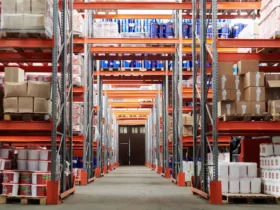Production is an integral part of any business. It forms the basis of tangible products and services and is essential to running a company. But what’s the difference between manufacturing and fabrication?
Manufacturing is putting raw materials through a process to create a finished product. It often involves more than one step and is doable on a large or small scale. Fabrication creates goods by combining diverse, standardized components to create a final product.
What is Manufacturing?
Manufacturing is putting raw materials through a process to create a finished product. It is a multi-step process doable on a large or small scale. In manufacturing, raw materials are first transformed into parts. These parts are then assembled and finished into a final product. Manufacturing can be done by hand, using machine tools, or combining the two.
But why is it important to the economy? Manufacturing is critical because it is one of the main drivers of economic growth. Manufacturing businesses create jobs and generate income, spur economic activity. Moreover, manufacturing helps to develop new technologies and products that better our lives.
What are the Different Types of Manufacturing?
Manufacturing processes are of different types, depending on the goods produced and the technique used. The main types of manufacturing are:
- Assembly: the stage involves a combination of manufacturing and components to form a complete product. This type of manufacturing is ideal for products made up of many parts, such as cars or computers.
- Subtractive: the process involves removing material from a larger piece to create the desired shape. The technique is often used for making precision parts. An example is those used in the aerospace or medical industries.
- Additive: Additive manufacturing adds material to create the desired shape. This type of manufacturing is often used for making complex shapes or prototypes.
What are the Benefits of Manufacturing?
Generating jobs and income: Manufacturing businesses create jobs. That helps generate revenue and spur economic activity.
Boosts productivity: it helps build new technologies and products necessary for boosting productivity.
Drives economic growth: the process is one of the main drivers of economic growth through innovation.
Improves quality of life: A lot of manufacturing creations help enhance our quality of life. It creates new technologies and products that can make our lives easier.
What are the Challenges of Manufacturing
Environmental concerns: Some manufacturing processes can generate pollution and other ecological problems, such as PCB manufacturing.
High costs: Manufacturing is at times a capital-intensive process. It needs high start-up costs and ongoing expenses.
Complexity: Manufacturing can be a complex process with many moving parts.
What is fabrication?
Fabrication is creating goods by combining diverse, usually standardized components. This process usually involves cutting, shaping, and assembling components for the desired product.
What sets fabrication apart from manufacturing processes is that the new products aren’t made from scratch. Instead, fabricators often work with existing products and components to create new goods. That can be done by modifying existing products or combining them in new ways.
Fabrication is essential to the economy. It allows manufacturers to create unique, original, and practical products. It is also a critical manufacturing process for businesses producing limited quantities of goods. A good example is a company selling custom furniture or one-of-a-kind jewelry.
Types of fabrication
There are several fabrication methods categorized depending on the technology used. The most common methods are:
- Casting: This is the process where metal is heated until it melts and then poured into a mold to solidify. This method is often used for products that are too complex to be made using other methods or for mass production. The disadvantages of casting are that it can be expensive, and the products often have a rough finish.
- Forging: It involves shaping metal using hammers or presses. This method is often used for products that need to be very strong, such as tools. The metal is heated until it’s soft, then hit with a hammer or placed in a mold.
- Stamping: This method is like forging, but it’s used for thinner metal sheets. The metal is placed on a die, and then a stamp is used to shape it. This method is often used for making car parts.
- Welding: Welding is the process of combining two pieces of metal using heat. This is a very versatile method with many different types of welding.
- Cutting: The cutting process involves using a tool to cut through metal for making smaller products or for shaping metal products. It’s used in machine shops to make parts for machines.
- CNC Machining: This is the process of using tools to remove metal from a product to make precision products or repair metal products.
What are the Advantages of Fabrication?
Faster and more cost-effective: It’s usually quicker and requires less investment compared to traditional manufacturing methods. This is because the process is customizable to the customer’s specifications. What’s more, there is no need for expensive tooling or machines.
More flexible: Fabrication is more flexible than traditional manufacturing methods. That is because the process can be customized to the customer’s specifications.
Very little waste: Very little waste is created during the fabrication process. That is because the process can be customized to the customer’s specifications, and there is no need for expensive tooling or machines.
What are the Disadvantages of Fabrication?
Less accurate: Fabrication is generally less precise than traditional manufacturing methods. That is because the process is often done by hand. There’s no guarantee that the finished product will meet the customer’s specifications.
Time-consuming: Fabrication can be time-consuming, especially when done by hand.
Expensive: Fabrication can be costly, especially when done by machine.
Dangerous: Some types of fabrication, such as welding, can be hazardous. Workers must take precautions to protect themselves from injuries.
Manufacturing vs. Fabrication – What’s the Difference?
The main difference between manufacturing and fabrication is the process involved. Manufacturing involves creating new products from scratch. Fabrication involves modifying or combining existing products to create new goods.
Manufacturing is more expensive and time-consuming than fabrication. But it is more accurate and can produce higher-quality products. Fabrication is more flexible and wasteful than manufacturing but is generally less precise.
Summary
Both manufacturing and fabrication are essential to the economy. Manufacturing creates new products and supports the growth of industries. Fabrication, on the other hand, helps businesses create unique and stylish products.
Both processes have advantages and disadvantages. But, the best option for a business depends on its products and the quantities they need to produce. But, overall manufacturing is better than fabrication in the long run.








